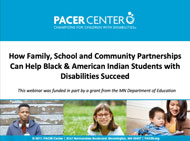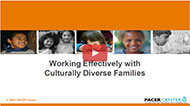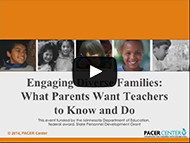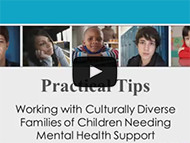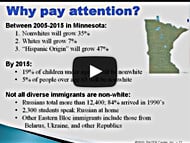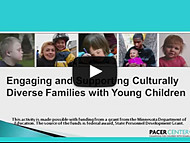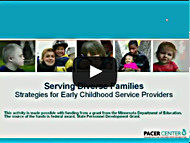Resources for Educators
Professional Development Trainings
No Certificates of Attendance
Only those who participate in the live workshop are eligible to receive certificates of attendance. No certificates will be issued for viewing the archived workshops on this page.
Getting Off to a Good Start: Positive Interactions with Diverse Families
The adage, “You never have a second chance to make a first impression,” applies to school professionals who want to establish good relationships with the families they serve. For a parent from a diverse community, the typical challenges are often compounded by differences in language, culture, and traditions. The first contacts provide the opportunity for the family to view the school experience as positive and responsive. The following tips are designed to help you create and maintain effective partnerships with families, leading to increased parent involvement, and ultimately better outcomes for children.
Setting the Stage for Positive and Productive Family Meetings
- Make it your school district’s goal to have interpreters available and involved in the earliest points of contact with families. Anticipate needs and proactively arrange for interpreters to be available based on a current demographic study of the families in your community.
- The first person who comes in contact with the family should ask about the need for an interpreter and translated materials. Do not assume to know what the family needs. Then, according to a predetermined process, the information should be relayed to the people who are working with the family.
- Call the parents before any type of meeting and answer questions they may have. Clearly explain the purpose of the meeting and the desired outcome. Explain who will participate and what they will specifically do during the meeting. Discuss the parents’ role and how they will be asked to participate.
- For in-home meetings, you may need to plan your visit around the family’s cultural and religious observations.
Conducting an Effective Family Meeting
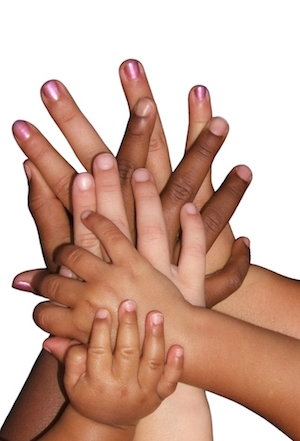
- At a first meeting, begin by sharing a little personal background information about yourself, including why you went into this profession and what you especially enjoy about it.
- It is essential to devote time to conversation and activities that will help to build trust. Expect that it may take more time to establish trust.
- Direct your comments and responses to both the mother and father. Let the family inform you if there is any preference in who receives information and makes decisions. Respect the family structure even when it is not your own experience and value system. It is not unusual for extended family members to be present. Recognize the importance, in many cultures, of designated community elders, spiritual leaders, and spiritual helpers, for whom families may go to for advice or approval.
- When the child has a suspected or diagnosed disability, it will not be unusual for the parent to initially say, “There’s nothing wrong with my child.” Acknowledge their viewpoint and recognize it may take time to develop enough trust in the relationship for the parent to hear and consider your input.
- There likely will be a need for you to provide an explanation of the process and systems involved. Even if the process and terminology was explained in a pre-meeting contact, describe them as you go along and invite the parents to ask questions.
- During the meeting, the parent may seem to understand the information that is being communicated. If asked directly, “Do you understand?” parents may answer “Yes,” even if they do not. You will need to check for understanding in informal ways as you go along such as: “Does that make sense to you?”; “What questions does that raise for you?”; “Does that sound right to you?”; and “Do you know what to do next?”
Understanding Differences in Culture
- In many Somali and Asian families, it is better not to initiate a handshake unless the individual extends their hand to you first. Depending on the individual’s religious beliefs, physical contact may be inappropriate at certain times.
- Asian families may use a combination of Western and Eastern medicine, philosophies, and approaches, which may include the use of massage, herbal remedies, and other healing practices. Include these interventions in the child’s plan if appropriate. For example, if the child would benefit from occupational therapy (OT) services, find out first what the family may already be doing in the area of massage and incorporate the activity into the OT plan.
- Depending on the culture, the level of eye contact may differ from what you are familiar with. It’s important to not interpret lack of eye contact to mean disinterest or disrespect.
- Because of the historical overrepresentation of African Americans in special education, African Americans may be reluctant to have their children identified as needing special education services if the child has a disability that is not visible.
- Realize that for some families, immigration status may be an issue of concern. This can cause some families to be very cautious in the way they disclose information to you.
- If language is a barrier and no interpreter is available (despite your best efforts) keep the meeting to the sharing of general information. When there is a language barrier, it is not possible to accurately determine eligibility for services. If at all possible, avoid using children as interpreters. Plan for an additional session to meet the need for language interpretation.
- Even when the family speaks English, do not assume they can read, especially at the high reading level of many public agency documents. In a sensitive and indirect way, check frequently for understanding. If you are taking notes or completing a form, read what you have written to the parent as you go along and before giving them the document. If you discover the parent cannot effectively read the materials, offer to provide the information in a different format.
- At the conclusion of the meeting, end on a positive note by praising the child or family and thanking the parents for their valuable input and participation.
Strategies for Success in Local Early Childhood Parent Outreach Activities Among Diverse Cultures
Print Version
- Identify multicultural population centers in your locality.
- Identify key leaders within each of those communities.
- Call and request the opportunity to meet in person to communicate the purpose and goals for an outreach effort to help children and families in their community. Explain how the leaders can be involved as partners. Example: Displaying brochures in a visible location.
- Whenever possible, enlist the help of parents of young children from the culture to accompany you and communicate the need with community leaders. To locate parents to accompany you, check with the local IEIC (Interagency Early Intervention Committee), and ask for referrals from ECSE (Early Childhood Special Education) staff or from advocacy organizations, such as PACER.
- When parents are not available to come with you, ask families for permission to use their family stories with photos when communicating with community leaders.
- Invite the leader to collaborate with you in developing an outreach strategy that makes sense for the particular community.
- Ask for help in identifying other potential partners within the community. It will be particularly helpful to enlist the help of individuals who speak the language and work for health, education, and social service organizations.
- Determine specific locations and methods to disseminate outreach materials. (Please see PHPc-133, “Potential Community Partners and Locations.” ) Consider community celebration and event calendars in your planning. Enlist the help of identified partners to distribute materials.
- Order or download the PACER/ Minnesota Department of Education (MDE) outreach materials by contacting PACER Center. Use a label or stamp to add your local contact information to the back of the outreach brochure.
- Plan follow-up activities for parents who indicate the need for more information.
Tips:
- Be positive and proactive. Regardless of availability of formal services, families benefit from being connected to other families, to disability organizations, and other informal resources. Establishing a need for services is often necessary for acquiring additional funding.
- Dedicate appropriate staff to the outreach effort. While expertise and experience in early childhood intervention is important, the ability to communicate in the language and understand the culture of the community may be more essential for initial outreach efforts.
- Recognize that families may very likely need someone to help them navigate the process. Have contact information available that refers them to community and advocacy resources, such as PACER. If possible, identify the name of a specific person for whom they can ask.
Conducting Family-Friendly School Events
- Distribute event information through multiples means of communication
- include flyer in student take-home folder
- email directly to families
- hand out in person at conferences or other school meetings
- post on school website and bulletins
- include in school newsletter
- print poster-size versions of the flyer and post on entrance doors and at the visitor check-in station
- Provide staff at the event who speak the various languages to greet and welcome parents who are English language learners.
- Provide interpreters and translated materials for informational sessions.
Download Example
Creating a family friendly flyer:
- Avoid using acronyms for locations or titles — spell everything out
- Make sure to list where participants can park and which entrance to use for the event
- Will there be food? Children welcome? Childcare available? For what ages? If not, specify that it will not be provided.
- Consider including the agenda or event items for the scheduled activities so families know what to expect or can “catch up” if they arrive late.
- Include speakers’ names and photos (if relevant). Indicate what school staff they can expect to see at the event.
- Create flyers in multiple languages so that all families feel welcome
- Provide a “save the date” piece several weeks before the event as well as a reminder the week of the event.

